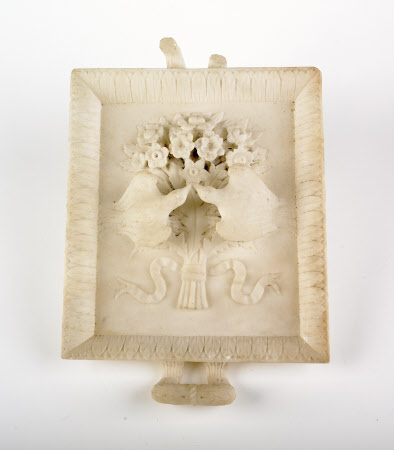An alabaster tray with an allegory of love
Volterran School
Category
Art / Sculpture
Date
c. 1820 - 1850
Materials
Alabaster
Measurements
35 x 218 mm; 250 mm (L)
Place of origin
Volterra (Italy)
Order this imageCollection
The Argory, County Armagh
NT 565254
Summary
Sculpture, alabaster; a tray with two birds and a bouquet of flowers; Volterra, Italy; c. 1820-1850. A decorative tray with two handles, one now broken, depicting two birds, their beaks touching, perched upon a bouquet of flowers. The two birds were a common symbol of love in the decades around 1800, so this design may have been mainly intended for sale to commemorate marriages. The tray was very probably made in Volterra, the centre of the alabaster-carving industry in mainland Italy at this time.
Full description
An alabaster tray with, in the recessed centre, a still-life carved in quite high relief, depicting a pair of small birds seated upon a bouquet of flowers, tied at the stems with a ribbon. The birds have raised their wings to form a sort of arch whilst their beaks touch. The border of the tray is formed from a frieze of palmette decoration whilst at each short end is a handle, one of which is now broken. Alabaster is a relatively soft stone that is easy to carve, whilst it also has an attractive translucency and whiteness which, at its best, approaches the purity of marble, but is very much less expensive. For all these reasons, alabaster has long been used for the production of sculptures, often on a smallish scale and on a serial basis. In Italy, the main centres for the production of alabaster sculptures were Trapani in Sicily and the Tuscan city of Volterra, where the tray is very likely to have been made. For centuries a centre for the alabaster-carving industry, workshops and factories in Volterra began from the late eighteenth century onwardsto produce figures, utensils and other useful objects, such as vases and light fittings, on an industrial scale. Rather than for the tourist trade, trays with this design may have been made principally for the wedding market, since the two canoodling birds with a bouquet of flowers was a popular symbol of love in the late eighteenth and nineteenth centuries. It is also found in Roman micro-mosaics, another decorative art industry that flourished in Italy around this time (Petochi 1981, p. 220, no. 4). A micro-mosaic picture at Anglesey Abbey shows for example two doves before a swag of fruit (NT 517511). In 1829, Walter McGeough Bond (1790-1866) married as his second wife Anne Smyth McGeough Bond (1805–1892). The large number of small sculptures and other souvenirs from Rome and elsewhere in Italy at the Argory makes it very likely that the couple made a journey to Italy after their marriage; it is an attractive notion that the alabaster tray might have been bought by the newly-weds on this trip. It could though have been acquired in Britain or Ireland, since in the nineteenth century the Volterra alabaster factories were efficient exporters of their wares throughout Europe. Jeremy Warren November 2022
Provenance
By descent; Walter McGeough Bond (1908-86), by whom given to the National Trust in 1979.
Makers and roles
Volterran School, sculptor
References
Petochi 1981: Domenico Petochi, I mosaici minuti romani dei secoli XVIII e XIX, Rome 1981
